Phenom II Performance System
The fully decked out Phenom II includes the best motherboard tested so far in our lab for the AM2+/AM3 CPUs. Because the top Phenom II is DDR2-only the motherboard is by necessity a DDR2 board. The Phenom II 940 and 920 will be phased out by the end of 2009 and replaced with the new 945 and 925, which support either DDR3 or DDR2 like the most recent Phenom II CPUs. The 945/925 are expected to begin shipping in April.
The 940/920 still outperform the Phenom II 810 even though the newer Phenom II features four cores like the older 940/920. At 2.6GHz the 810 is slower than the 940/920, and the multiplier is locked where the 940 BE features an unlocked multiplier. In addition, the L3 cache on the 810 is 4MB where the 940/920 is 6MB. While the 810 is an excellent CPU, it really doesn't challenge the 940/920 for the performance crown. The advantage of the 810 is the dual DDR2/DDR3 memory controller. Frankly, we have yet to see a real performance advantage for DDR3 memory on the Phenom II so there was no real reason not to choose the current 940 for the Phenom II Performance system.
The new 945/925 will also be 6MB L3 cache, and the HT or uncore speed will be 2.0GHz instead of the 940/920 speed of 1.8GHz. The real impact of this is very small, but when the 945/925 enter the pipeline they will provide more options at the top of the Phenom II line. This will also likely create some bargain prices for the 940 and 920 processors that remain in the market after the 945/925 introduction.
Anand is completing testing for a massive SSD roundup that will be published soon. There are new performance and value leaders that will be revealed in that roundup, and we will definitely be recommending SSD drives and SSD RAID boot arrays in future System Buyers' Guides. For now, we are holding off on any recommendations pending final testing. Besides, you can easily add an SSD down the road if the need arises.
While the Phenom II 940 is definitely the most powerful AMD processor yet released it is not really a competitor to today's top Intel Core i7 processors. However, as has been said in every recent review of Phenom II, it definitely competes well with Intel's Core 2 architecture which means it competes with Intel CPUs through the $290 upper midrange price point. Since the processor is upper midrange, the components selected are top-performing for their price but not always the best you can buy. You could easily extend the Phenom II Performance system to a 30" monitor and a more powerful CrossFire or SLI graphics system. AMD fans who are avid gamers may choose that route, but we kept the selections more in line with the midrange price and performance of the Phenom II. For the money the Performance Phenom II system is a heck of a system, as we hope you will agree.
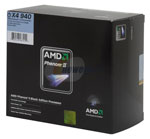 |
You can read our
review of the Phenom II X4 and the
Phenom II X4 810 & X3 720 for additional information. The Phenom II 940 X4 at 3.0GHz is the fastest of the currently shipping AMD Phenom II processors. The Phenom II is very similar in L2/L3 cache configuration to the recently introduced Intel Core i7. Performance is also comparable to the best Intel Core 2 chips. As the first 45nm AMD processors, the Phenom II also overclocks very well, finally approaching the overclocking levels enjoyed by Intel since the introduction of the Core 2 Duo.
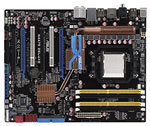 |
We've paired the Phenom II 940 with the superb ASUS M4A79 Deluxe. At $200 the ASUS is not cheap or even a great value for a 790FX/SB750 setup, but it is the most loaded, best performing, and most overclockable AMD board we have used this year. ASUS loads the board with Gigabit LAN, IEEE 1394 support, four PCI-E x16 slots (dual x16, tri x16/x8/x8, or quad x8), two PCI slots, an eSATA port, and six 3Gb/s SATA ports featuring RAID 0/1/5/10. The M4A79 Deluxe works very well with Phenom II and end-users will not be disappointed in performance or overclocking capabilities. Memory is DDR2 as AM3 DDR3 boards are just now entering the market. Until a DDR3 board dethrones the M4A79 Deluxe it is the top board for a top Phenom II.
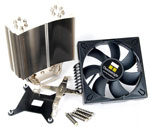 |
A number of old and new coolers work well on AM2+/AM3 processors, but the cooler choice for the Performance Phenom II is still the Thermalright Ultra-120 eXtreme. This is basically the top performing Thermalright Ultra-120 eXtreme from our Core 2 tests. Thermalright has been changing the packaging and names of their Ultra-120 coolers so you may have to look closely at the new packages and descriptions to make sure you are getting the Ultra-120 eXtreme. The original Ultra-120 also performs very well with the Phenom II processors and will save you about $15 to $20 if you are stretching a budget.
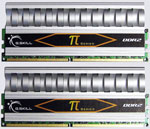 |
Memory is very cheap today, so the Performance Phenom II is paired with two 4GB kits for a total of 8GB. You may be wondering why we have chosen 8GB of G.Skill DDR2-1100 when AMD warns that the maximum speed for 4 DIMMs is DDR2-800. That warning is certainly true on lower end boards, but we have found the ASUS M4A79 Deluxe paired with quality memory can run 4x2GB at DDR2-1066 without any trouble. The 1100 speed also gives some headroom should you decide to overclock this unlocked Black Edition Phenom II 940.
For the video card we have selected the
MSI R4870-T2D1G Radeon HD 4870 1GB. As pointed out in the recent
Multi-GPU comparison, the 4870 1GB provides optimum performance on a 1080p monitor such as the BenQ 24" chosen in this system. Higher spec graphics and high-end CrossFire or SLI really require a 30" display (2560x1600) to see the performance improvements they bring to the system. The MSI is a well-regarded card that is just $195 after the current $25 rebate. The 4870 1GB is a very popular card because it matches well with the monitors most users actually own and buy. It is available from MSI, Diamond, ASUS, HIS, Power Color, and others so you can shop for the best buy.
The hard drive used in the Performance Phenom II system is the Western Digital Caviar Black 1TB (1000GB) with true 7200RPM speed and a 32MB cache. The cheaper Western Digital drives use a "variable speed" 5400-7200RPM spindle that performs well and is very quiet, but the 7200RPM drives are a bit faster.
We feel the optical drive for the Phenom II Performance system needs to both play Blu-Ray disks and burn 25GB/50GB Blu-Ray discs. We have upgraded the optical drive to the flexible LG GGW-H20LK burner, which is now selling for just $200 and has the ability to read and write Blu-Ray disks. It also can burn DVDs at 16x speed in single or dual-layer formats. A DVD burner is also included to simplify disk archiving and backup tasks. Two optical drives can be very handy in any system.
The speakers have been upgraded to the Logitech G51 155W RMS 5.1 surround sound speakers. The G51 system works well with the ASUS onboard Realtek ALC1200 audio. They also perform well with the addition of sound card if you decide sound needs an upgrade. The $40 rebate is gone for the G51 system, but they are still a very good value in a powered speaker system.
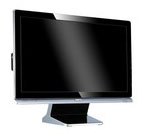 |
The LCD display resolution is the same 1080p HD resolution chosen for the Phenom II overclocking systems. The size of the monitor is now 24" so everything on screen is just a little larger. The BenQ E2400HD 24" provides inputs for whatever graphics adapter you may need with HDMI, DVI, and an analog VGA port. Panel speed is rated at an incredible 2ms, but we have found most current LCD panels perform similarly and the speed rating does not really guarantee very much. The BenQ monitor provides a sharp image, good colors, and fast panel speed at a very good price of $280. However, there are certainly larger, better, and more expensive panels available. For more information on what matters in a monitor and how to read LCD specifications, take a look at our
Holiday 2008 Display Guide.
The remaining items are upgrades of the Overclocking System. The keyboard and mouse have been upgraded to high performance choices in the Logitech G5 USB laser mouse and the Logitech G15 precision control keyboard. If those choices are not important to you, the substitution of a Microsoft wired OEM keyboard and optical mouse for $16 could save you $133 on the system price. Alternately, the drop back to the Logitech G11 keyboard and MX518 8-button optical mouse could save you $50 off the performance choices with little compromise in system performance.




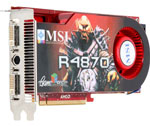
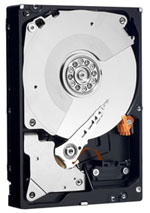














49 Comments
View All Comments
genpat - Monday, March 2, 2009 - link
All sorts of messed up links on overclocking page as wellWesley Fink - Monday, March 2, 2009 - link
The links were added by web editors in the final prep for posting. I have been checking links and correcting them where I find errors.Frallan - Monday, March 2, 2009 - link
However only 4-8 Gb Memory. Is this for a reason i.e. does the system perform worse with 16Gb installed?
Wesley Fink - Monday, March 2, 2009 - link
With 4 dimm slots you would need 4GB dimms to populate the board with 16GB. The only 4GB dimms readily available are the Kingston 8GB DDR2-800 CAS6 kit in DDR2. They sell for over $400 for two dimms (8GB), or $800+ for 16GB.We're not opposed to more memory, but 16GB is really not very practical right now.On the Overclocking systems generally the more memory slots filled the more limited the memory overclocking capabilities. Filling two slots with fast 2GB dimms (total 4GB) seemed the best formula for best overclocking potential. We didn't even consider 8GB (4x2GB) as an option for the OC systems. Since the Entry system is about price and value we also did not consider 8GB there.
marc1000 - Monday, March 2, 2009 - link
honestly, more than 4gb for home use is a waste. I have two rigs at home (one for me, the other for my girl). Mine is 4gb and her is 2gb. With dual-core cpu's and 4gb of memory you will never have a performance-wise problem on your computer. Of course you may always want the "better and fastest", but only a few percent of users are concerned about that. The vast majority only want to use some Word-app and read some emails.Also, for these folks 32bit and 64bit OS are exactly the same things. With Windows Vista hard-coded limitation to only 4gb, there really is no need to go beyond 4gb. By the way, my OS is 32bits so I'm "loosing" 700mb to this artificial limit (and I will replace a hidden DLL soon to make it use the full 4gb).
DeepBlue1975 - Thursday, March 5, 2009 - link
So true.Had 6gbs on my machine for a while (had 2, then added 4 more), and as soon as I compared the performance delta between that and 4gbs, I ended up selling the old 2gbs so I now have just 4gbs. It is plenty for my usage pattern.
Also I don't get why the editor seems to implicate that a mid range CPU such as a phenom II will be mostly paired to pretty low end devices for anything.
I mean, come on, even if you're only an ocassional gamer, an IGP won't cut it. I don't see that even as well fitted enough for watching HD movies.
v12v12 - Wednesday, March 4, 2009 - link
"Hidden DLL" you say? Please do explain/expand for those that don't already know.JarredWalton - Monday, March 2, 2009 - link
Only Vista 32-bit has a 4GB limitation; that's the whole point of 64-bit OSes. Of course, only 64-bit apps can access more than 3GB even on Vista 64-bit... perhaps that's what you meant? (I still curse Adobe on a regular basis for their lack of 64-bit applications!)Ryan Smith - Tuesday, March 3, 2009 - link
Close. 32bit apps that are LargeAddressAware can hit up to 4GB under Vista x64.This doesn't include the other benefits of more memory of course, such as additional applications being able to use their own chunk of memory without having to share with other memory-intensive applications.